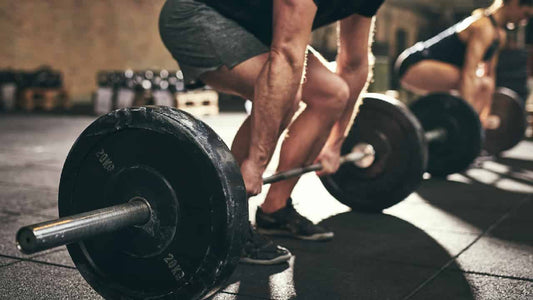The dumbbell rear delt (deltoid) fly, otherwise known as the dumbbell reverse fly, is an exercise that increases deltoid muscle strength and definition.
Although this movement works several other upper body muscles, the main focus is on your rear (posterior) deltoids, located in the shoulders. Rear delt flys are particularly beneficial for addressing shoulder imbalance and preventing injuries.
This exercise should be a staple in any shoulder workout, as it helps to build well-rounded shoulders, or “boulder shoulders” as it’s commonly termed, and greatly improves your shoulder workout routine.
This article discusses the benefits of rear delt flies, how to do them correctly, and other variations and alternatives that you should be including in your workout program.
Let’s get started!
What is a Dumbbell Rear Delt Fly?

The rear delt fly is a shoulder exercise that can be performed with a cable machine, pec dec machine, or dumbbells. The move involves hinging at the hips and raising weights to your sides in an arching motion, while maintaining a slight bend in the arms to properly engage the rear delt muscles.
This is a staple shoulder movement that should be included in any shoulder workout to help build the rear of your shoulders, a part of the shoulders which is typically a little more neglected compared to the front and sides of the shoulders.
What Muscles are Worked by the Dumbbell Rear Delt Fly?

The dumbbell rear delt fly works several upper body muscles, but primarily works your rear delts. The deltoids are separated into three main fibers - the anterior, lateral, and posterior deltoids. Your posterior delts get the most attention from this exercise.
However, as mentioned, this exercise also works some other secondary muscle groups. The dumbbell rear delt fly is also an effective exercise for the trapezius, located at the top of your shoulders and neck, and the upper back muscles.
Additionally, your core muscles are also activated and engaged during this exercise to help stabilize your body doing the movement.
Understanding the Anatomy and Importance of Rear Deltoids
While we've briefly touched on the primary and secondary muscles engaged during the dumbbell rear delt fly, it's also crucial to understand the underlying anatomy of the rear deltoids and their significance in both athletic performance and daily activities.
Anatomical Overview
The rear deltoids, or posterior deltoids, are one of the three muscle segments that make up the deltoid muscle. These are located at the back of the shoulder and are responsible for the movement of the arm backward, playing a pivotal role in shoulder extension and external rotation.
Role in Shoulder Health and Stability
The rear deltoids are often overshadowed by their anterior and lateral counterparts, yet they are crucial for maintaining shoulder balance and stability. Strengthening the rear deltoids can prevent common shoulder injuries by ensuring that the shoulder joint is not overly dominated by the actions of the anterior (front) and lateral (side) deltoids.
Contribution to Postural Integrity
Beyond their role in physical performance, the rear deltoids are integral to maintaining good posture. In a world where many of us spend hours hunched over computers or smartphones, these muscles counteract the forward shoulder roll that contributes to a slouched posture. Strengthening the rear deltoids helps pull the shoulders back into a more neutral position, alleviating stress on the neck and spine.
Enhancing Athletic Performance
For athletes, strong rear deltoids contribute to a wide range of motions essential in sports—from the powerful arm swings in tennis and baseball to the shoulder stability required in swimming and gymnastics. By ensuring the rear deltoids are not neglected, athletes can enjoy improved performance and reduced risk of shoulder-related injuries.
What are the Benefits of the Dumbbell Rear Delt Fly?
Improve your posture
These days, many of us are sitting at a desk working away for hours. This can wreak havoc on our posture, something which can sometimes be overlooked as a contributing factor to poor health.
Thankfully, many exercises can be incorporated into a daily routine or workout program that can help improve posture. One of these exercises is the dumbbell rear delt fly!
If you tend to round your shoulders and appear “hunched”, the dumbbell rear delt fly can help correct this problem by tightening your upper back.
Additionally, the core engagement will also assist with overall posture improvement by helping to maintain a straight back.
Increase shoulder strength
This exercise can not only be useful for everyday posture improvement, but it can also strengthen your shoulders by developing your posterior deltoids.
While this is considered an accessory exercise, the dumbbell rear delt fly can boost your performance in compound exercises too, such as the overhead press, deadlift, and bench press.
Strong shoulders are an important area of any training program, and your rear delts play a bigger role than you may think!
Enhance aesthetics
If you are exercising to improve your physical appearance and aesthetic, you should prioritize shoulder exercises. Many bodybuilders put a lot of emphasis on their arms and chest, leaving them with disproportionately smaller shoulders.
This isn't the best look, especially if you're planning to step on stage in the future! Though muscle symmetry is not only important for bodybuilders but also for generally promoting a better balance in your body.
Dumbbell Rear Delt Fly: Technique and Form

Now we have discussed the benefits of the dumbbell rear delt fly, let’s take a look at how to perform this movement correctly!
For this movement, all you will need is a set of dumbbells - we recommend starting light.
For the setup:
- Stand up tall with your feet shoulder-width apart
- Hinge at the hips until your back is almost parallel to the floor
For the action:
- Maintain a slight bend in your elbows and contract your rear deltoids to bring the weight up and out to your sides
- Squeeze your shoulder blades together at the top of the movement
- Bring your arms back down to the starting position and repeat for reps
Other points to consider:
- Ensure you keep your core tight and your back and shoulders engaged throughout the movement
- You should aim to complete around 3-4 sets of 10-12 reps. Though, feel free to change this up as you get more comfortable with the movement.
Common Mistakes of the Dumbbell Rear Delt Fly
While this movement seems relatively easy to perform, there are some common errors to be aware of:
Bringing your arms backward
Rather than bringing arms up on a lateral plane, it's a common error to see lifters bring the dumbbells back on a diagonal plane towards their glutes. This results in too much back activation instead of rear delts.
To avoid this, keep the dumbbells moving outward on a lateral plane to work your shoulders.
Incomplete reps
This is an issue among many lifters when doing accessory movements. It can be tempting to grab a heavy pair of dumbbells are push our reps until failure, but this always results in the worst form.
The rear delts are only a small muscle group, so they aren't particularly strong nor do they need to be. Try not to compromise the movement by picking weights that are too heavy. You will see better results if you lift a lighter weight with the correct form and complete reps.
Bending your arms too much
While ideally, you want to be bending your arms slightly, too much bend can turn the movement into a bent-over row. The muscles in your upper back will activate to help stabilize the motion, however, you want to try to target the shoulders more.
Dumbbell Rear Delt Fly: Variations

While the dumbbell rear delt fly is one of the best movements for the shoulders, there are some variations and alternatives to consider which can help improve your overall upper body training!
Single-arm rear delt fly
This movement is almost exactly the same as the dumbbell rear delt fly, but it uses just one arm instead of two. This can help improve muscle imbalances!
Chest-supported dumbbell rear delt fly
If the traditional movement causes you to strain your lower back, try lying face down on an incline bench. Instead of relying on your core to stabilize the motion, the bench will do the work for you. This also helps to better isolate your rear delt muscles.
Bent over cable rear delt fly
You can also perform the rear delt fly with a cable machine. Setting the pulley at a low position and hinging at the waist, bring the weight upwards, as you would with dumbbells.
Dumbbell Rear Delt Fly: Alternatives

The standing rope face pull
This movement involves a cable machine using the rope handle. Keeping your arms elevated, drive your elbows back by pulling the handles to both sides of your face. You should feel your shoulder blades pinch together, which is a strong indicator of your rear delts being worked!
Bent arm lateral raise
Using a set of dumbbells, get into a standing position and bend your elbows to a 90-degree angle. Tuck your elbows to your sides and keep your palms facing inwards. You should now contract your deltoids to raise your bent arms to the sides.
Bent over face pull
This movement is a hybrid of the face pull and rear delt fly. Hinge at the hips and raise a dumbbell towards your forehead. Ensure you are keeping your back straight, and core and shoulders activated and engaged.
The Take-Home
The dumbbell rear delt fly is one of the most effective shoulder movements.
This exercise should form part of your shoulder workout routine as an essential accessory to help increase overall strength, improve posture, and help build the sought-after “boulder shoulder” aesthetic!














